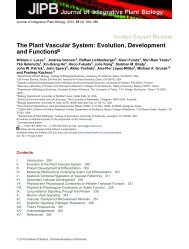New species of Solanum and Capsicum (Solanaceae) from Bolivia ...
New species of Solanum and Capsicum (Solanaceae) from Bolivia ...
New species of Solanum and Capsicum (Solanaceae) from Bolivia ...
Create successful ePaper yourself
Turn your PDF publications into a flip-book with our unique Google optimized e-Paper software.
2006] nee et al.: solanum <strong>and</strong> capsicum (solanaceae) 341<br />
cm; pedicels 9–11 mm in flower, to 15 mm<br />
<strong>and</strong> somewhat thickened in fruit, exp<strong>and</strong>ed<br />
distally to 1.5 mm in diameter, recurved,<br />
widely spaced, 7–14 mm apart, articulated at<br />
the base. Calyx 6–7 mm long, the tube 2–3<br />
mm, the lobes in anthesis to 4 × 1.4 mm including<br />
the ca. 1 mm long caudate tip,<br />
oblong-ovate, with a few sessile stellate<br />
hairs, unarmed; fruiting calyx somewhat accrescent,<br />
the lobes to ca. 6.5 × 3.2 mm;<br />
corolla ca. 1.3 cm in diameter, 12 mm long,<br />
stellate to stellate-pentagonal, white, lobed<br />
about half way, the tube 6 mm, the lobes ca.<br />
6.5 × 3.5 mm, triangular, tomentose abaxially<br />
with small sessile stellae, glabrous adaxially;<br />
filaments glabrous, the free portion ca. 2 mm,<br />
the filament tube absent; anthers ca. 5 × 1<br />
mm, linear-tapered, not connivent, yellow,<br />
the pores minute <strong>and</strong> directed distally, not<br />
opening into longitudinal slits with age;<br />
ovary glabrous; style ca. 8 × 0.5 mm, cylindrical,<br />
straight, glabrous; stigma capitate.<br />
Fruit (immature) an oblong-ovoid berry, ca. 1<br />
cm in diameter, the color when ripe unknown,<br />
glabrous. Seeds unknown.<br />
Distribution <strong>and</strong> ecology.—The few collections<br />
to date show <strong>Solanum</strong> moxosense is<br />
adapted to weedy or disturbed areas around<br />
cattle pens, but the original adaptation is<br />
probably to natural disturbances <strong>of</strong> the seasonally<br />
inundated savanna in which Trinidad<br />
is situated. So far this <strong>species</strong> is only known<br />
<strong>from</strong> the immediate vicinity <strong>of</strong> the city at ca.<br />
200 m in elevation. It is a weed in the city <strong>of</strong><br />
Trinidad <strong>and</strong> was also seen commonly on dirt<br />
roads <strong>and</strong> near cattle yards near Puerto Almacén,<br />
7 km SW <strong>of</strong> the city, but not yet<br />
blooming there, so no specimens were collected.<br />
No collections have been seen <strong>from</strong><br />
the Estación Biológica del Beni, ca. 150 km<br />
to the west, one <strong>of</strong> the few areas <strong>of</strong> the Beni<br />
plains that has been thoroughly explored<br />
botanically.<br />
Phenology.—Flowering in January <strong>and</strong><br />
August.<br />
Etymology.—The name refers to the<br />
Llanos de Moxos, one <strong>of</strong> the largest seasonally<br />
flooded savannas in the world. This part<br />
<strong>of</strong> <strong>Bolivia</strong> is a perfectly flat alluvial plain between<br />
the pre-Cambrian shield <strong>of</strong> crystalline<br />
rocks to the east <strong>and</strong> the Andes to the west,<br />
which provide the recent sediments <strong>from</strong><br />
their numerous rivers flowing northwards to<br />
the Madeira <strong>and</strong> then the Amazon. The region<br />
has been identified as a center <strong>of</strong> diversity<br />
<strong>and</strong> endemism <strong>and</strong> a priority for conservation<br />
(Beck & Moraes-R., 1997).<br />
Additional specimens examined. BOLIVIA. Beni.<br />
Prov. Cercado: Trinidad, on savanna, 200 m, Aug 1944<br />
(fl), Cárdenas 3525 (MO, US); Trinidad, 14°50'S,<br />
64°55'W, 150 m, weedy areas in the town, 25 Feb 1987<br />
(fl, fr), Nee 34261 (MO, NY).<br />
<strong>Solanum</strong> moxosense is a much more nearly<br />
glabrous plant than related <strong>species</strong> in the<br />
<strong>Solanum</strong> multispinum <strong>species</strong> group (sensu<br />
Whalen, 1984) or sect. Melongena subsect.<br />
Lathyrocarpum G. Don (sensu Nee, 1999),<br />
most <strong>of</strong> which are found further south in<br />
southern <strong>Bolivia</strong> (<strong>from</strong> about Santa Cruz de<br />
la Sierra south) into northern Argentina <strong>and</strong><br />
especially Paraguay. It appears most similar<br />
to <strong>species</strong> such as S. hieronymi Kuntze <strong>from</strong><br />
dry areas <strong>of</strong> southern <strong>Bolivia</strong>, northwestern<br />
Argentina <strong>and</strong> Paraguay, or S. comptum C. V.<br />
Morton <strong>of</strong> eastern Paraguay <strong>and</strong> northeastern<br />
Argentina, but these <strong>species</strong> are more robust<br />
in all respects, more densely stellatetomentose,<br />
<strong>and</strong> display the very spiny fruiting<br />
calyx typical <strong>of</strong> the group.<br />
In habit, <strong>Solanum</strong> moxosense resembles<br />
the Cuban endemic <strong>Solanum</strong> chamaeacanthum<br />
Griseb., but that <strong>species</strong> appears not to<br />
root along the nodes, the leaves are fleshier,<br />
smaller (1.5–4 × 1.2–2 cm), with more regular<br />
<strong>and</strong> more acute lobes, <strong>and</strong> the plant is<br />
more densely armed with longer prickles (to<br />
6.5 mm long). <strong>Solanum</strong> moxosense is also<br />
similar to the creeping <strong>species</strong> S. flagellare<br />
Sendtn. <strong>and</strong> S. reineckii Briquet <strong>of</strong> coastal<br />
southeastern Brazil, but differs again by more<br />
pr<strong>of</strong>use rooting at the nodes <strong>and</strong> a suite <strong>of</strong><br />
other characters.<br />
<strong>Solanum</strong> pedemontanum M. Nee, sp. nov.<br />
Type: Ecuador. Napo: Añangu, Parque Nacional<br />
Yasuní, 0°31–32'S, 76°23'W, 30<br />
May–21 Jun 1982 (fr), B. Øllgaard et al.<br />
39285 (holotype: QCA; isotype: NY).<br />
Fig. 9<br />
Liana lignosa, aculeis solum recurvis 1.5–3 mm<br />
longis armata. Folia plerumque geminata, altero minore,<br />
folia longiora anguste eliptica, 10–18 × 2.5–6.5 cm, integra<br />
vel angulati-lobata, supra inermia, subtus costa aculeis<br />
recurvis armata. Inflorescentiae extra-axillares, in-
















